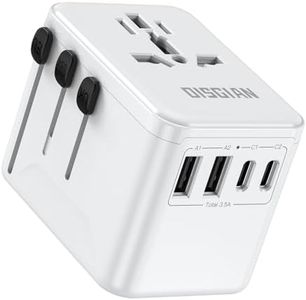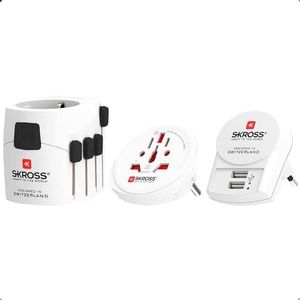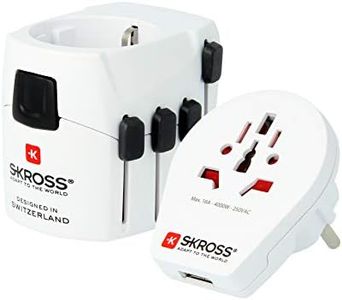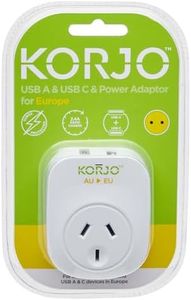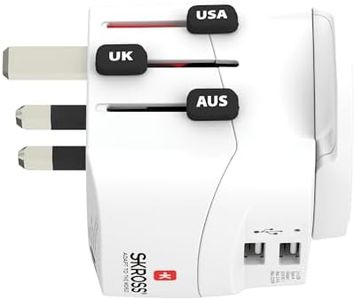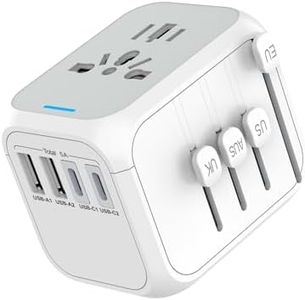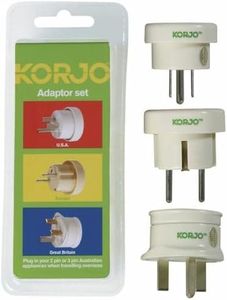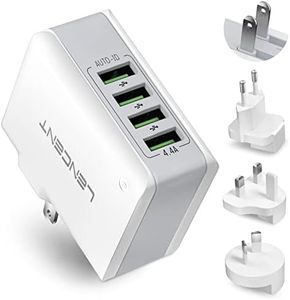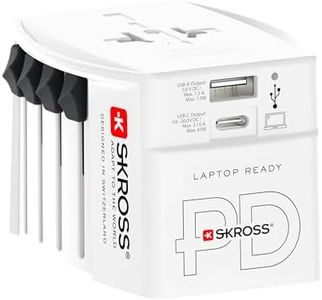We Use CookiesWe use cookies to enhance the security, performance,
functionality and for analytical and promotional activities. By continuing to browse this site you
are agreeing to our privacy policy
10 Best Universal Travel Adapters
From leading brands and best sellers available on the web.Buying Guide for the Best Universal Travel Adapters
Buying a universal travel adapter may seem simple, but it’s important to choose the one that truly meets your travel needs. Universal travel adapters allow you to plug your electronic devices into foreign outlets that have different plug shapes and voltage standards than your home country. A good adapter can keep your gadgets powered and safe no matter where you go. Before buying, it’s crucial to understand which specifications really matter and how they relate to your travel habits. This will help you avoid adapters that are either overkill or not compatible with the places you visit.Plug CompatibilityPlug compatibility refers to the range of plug types that the adapter can fit or convert. This dictates which countries you can use the adapter in. Most universal adapters support major plug types, like the US, UK, EU, and AU standards, but some cover more regions than others. When considering plug compatibility, know where you’re traveling—if you mostly visit just a couple of countries, you might not need an adapter that covers every plug type in the world. If you travel widely or aren’t sure where you’ll go next, pick one with support for as many regions as possible. Always check your destination’s plug type before you buy.
USB Ports and Charging OptionsMany universal adapters come with built-in USB ports and sometimes even USB-C ports, letting you charge phones, tablets, and other devices directly—no extra charger needed. The number and type of USB ports determine how many devices you can charge at once and whether newer devices will charge efficiently. If you have multiple devices or travel with others, pick an adapter with several ports. For solo travelers with only one or two gadgets, a simpler one-port model may be enough. Make sure the ports support fast charging if that’s important for your devices.
Maximum Power Rating (Wattage/Amperage)The maximum power rating tells you how much electrical load the adapter can handle safely. This is usually listed in watts (W) or amps (A). It’s crucial because if your devices draw more power than the adapter can supply, it could overheat or fail. Low-powered adapters are fine for charging phones and laptops, but if you want to use higher-power devices like hair dryers or irons, you’ll need a higher-rated unit. Always check the wattage of your devices and compare it to the rating on the adapter to avoid compatibility issues.
Voltage ConversionNot all travel adapters convert voltage; many only change the plug shape. Voltage conversion is needed if your device’s voltage doesn’t match the local supply (e.g., using a US device rated for 110V in Europe, which uses 220V). Some travel adapters include a voltage converter, but most don’t. If your devices are “dual voltage” (listed on the charger as something like 100-240V), you don’t need conversion. If your gadgets are single voltage, a converter is necessary to avoid damaging them. Check your device’s label before you travel to know what you need.
Size and PortabilityThe size and weight of a travel adapter can affect how convenient it is to carry around. Some adapters are compact and lightweight, perfect for minimalists or frequent movers, while others are bulkier, sometimes offering more features. If you like to travel light or are often on the move, favor slim, easy-to-pack adapters. If you plan to stay in one place or need more charging possibilities, a larger adapter may be acceptable.
Built-in Safety FeaturesSafety features like surge protection, fuse systems, and fire-resistant materials help prevent damage to your devices and keep you safe from electrical hazards while abroad. Surge protection guards against voltage spikes, while replaceable fuses can protect both your adapter and gadgets. If you’re bringing valuable electronics or traveling in regions with unpredictable power, prioritize adapters with solid safety features. Even if you’re only charging simple items, safety is always a smart consideration for peace of mind.




